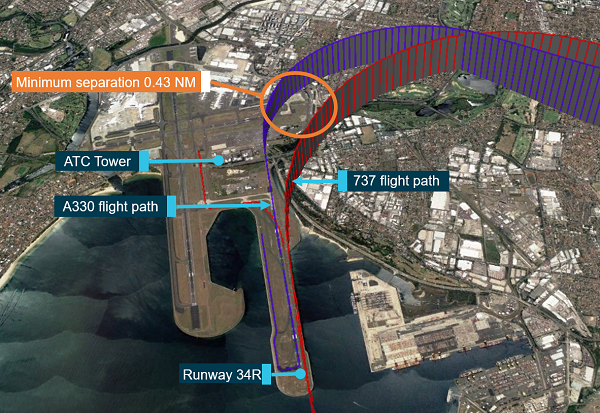'Very close' Qantas jets came within 800m of each other
16 January, 2020
3 min read
By joining our newsletter, you agree to our Privacy Policy


The captain of a Qantas Airbus A330 told air traffic controllers that another Qantas jet undertaking a missed approach on the same runway came “very close” during an incident at Sydney Airport in August
The Airbus A330 involved in the August 5, 2019, incident was taking off on runway 34 Right as a Boeing 737-800 landing on the same runway was instructed by air traffic control to perform a go-around.
An Australian Transport Safety Bureau preliminary report said the two came within 796 metres (O.43nm) laterally and about 152 metres (500ft) vertically, setting off the A330s airborne collision avoidance alert.
READ: Iran makes arrests over downed Ukrainian jet.
The minimum separation inside terminal airspace is 1000ft vertically and 3nm laterally but this can be reduced by a tower controller who has the aircraft in sight.
The Melbourne-bound A330 had started its take-off roll when the air traffic controller, an otherwise experienced hand training under the supervision for the aerodrome controller-east (ADC-E) position, determined that there would be insufficient space between the two aircraft if the Qantas 737 continued to land.
He instructed the 737 to conduct a go-around and the aircraft lost separation as both turned to the right.
“The ADC-E controller reported that he had both aircraft in sight,'' the report said.
"In an attempt to increase separation between the two aircraft, he instructed the 737 flight crew to turn further right,’’ the report said.
“The 737 was then at about 980 ft, which was below the minimum vectoring altitude (at night).
“As both aircraft converged, the A330 flight crew received a traffic advisory alert from their aircraft’s airborne collision avoidance system (ACAS).
“The A330 first officer, who was pilot flying, then saw the 737 in close proximity and, in response, reduced the aircraft’s angle of bank to reduce the turn towards the 737.
“The captain of the A330 made a radio transmission to advise the ADC-E controller that it was ‘very close’. The controller then issued an instruction to the A330 flight crew to turn left.”
The A330 was on a standard instrument departure while the 737 was on a landing approach using the global navigation satellite system.
The air traffic controller and his supervisor said they could see the two aircraft and applied visual separation.
The preliminary report, which does not include an analysis of the incident but simply states the facts, said the air traffic controllers did not issue safety alerts to the aircraft because they considered visual separation existed.
ATSB transport safety director Dr Stuart Godley said The ATSB would look at the design and risk assessment of the standard instrument departures and missed approaches from Sydney’s 34R runway as the investigation continued.
Other factors to be investigated included air traffic control procedures; controller training and controller actions; flight crew actions and the operator’s procedures for the 737 and A330; coding of flight management system navigation databases; and further analysis of flight data recordings and ATC recordings.
Get the latest news and updates straight to your inbox
No spam, no hassle, no fuss, just airline news direct to you.
By joining our newsletter, you agree to our Privacy Policy
Find us on social media
Comments
No comments yet, be the first to write one.

